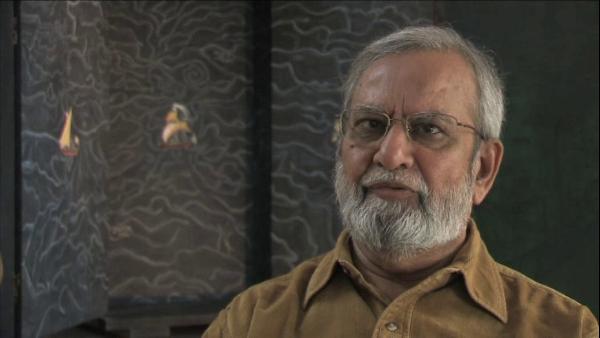NEXT STORY

Teaching history of art
RELATED STORIES

NEXT STORY

Teaching history of art
RELATED STORIES


|
Views | Duration | |
|---|---|---|---|
| 11. Mohandas Gandhi and writing | 59 | 03:58 | |
| 12. Family and going to Baroda | 60 | 05:39 | |
| 13. Life and people at Baroda | 1 | 75 | 09:20 |
| 14. Meeting other artists and developing my own style | 59 | 04:33 | |
| 15. The art scene in the '60s and my subject matter | 69 | 04:14 | |
| 16. Teaching history of art | 51 | 09:26 | |
| 17. Literary activities (Part 1) | 48 | 06:03 | |
| 18. Literary activities (Part 2) | 37 | 04:16 | |
| 19. Group 1890 and having a show | 116 | 05:53 | |
| 20. Other members of Group 1890 and our beliefs | 87 | 04:04 |


I had three shows during that time. One was in... first in Jehangir and then in a gallery in Delhi and then another in Bombay. It was in a hotel in,Taj Mahal Hotel. There was a gallery called Taj Art Gallery where I had my show.
But there, in that period there would be very few galleries in either Bombay or...
Very few galleries, hardly any galleries. There were about three or four galleries in Delhi and four or five galleries in Bombay. That’s all. And these were all artists, you know, who, all these artists, you know, were very, very, you know, they were... I mean, there was no market, if that is the question. There was no such thing as market. Very limited clientele, I think mostly foreign clientele, even diplomats, and some architects and others who bought their work. Or... house, corporate houses or business houses like... I think Air India bought a lot. My first painting was bought by Air India when I had a show and there was a man who, Jal Cowasji, I think. He was a public relations man and he used to go to every exhibition and they would buy. So, Air India had the biggest collection in those days. I don’t know what happened to that collection.
And what was your sort of subject matter, area then?
I think besides the horse thing my sort of imagery was related to either sort of some kind of tormented figures or landscapes, very, highly expressionist and I did a lot of also images which were, you know, I mean, they were relating to trees but they were not specifically focussed on that but there were, and then also there was a figurative, a lot of figurative imagery. But I worked kind of in that period of time in a frenzy. You know, I’d work throughout the day or the night and I would destroy a lot and repaint, partly because in those days, when I got to... I had a lot of material. It was the medium that allowed us to use it very liberally. We sort of used a medium with wax, double-boiled linseed oil and wax. It was all boiled. And then we would have, you know, what we call powder colours, the hardware colours, because as young artists we couldn’t afford to buy Winsor and Newton or even Camlin colours. So, we would buy only those which were not available in the hardware shops and mixed them. And sort of thick, it was impasto, you know. And I think that whole period was full of that kind of an excitement for the expressionist painters. We all started with that. And the three exhibitions that I had during that period of time, they were all full of that.
Expressionist means what in this...?
Well, at one level they were kind of very, highly charged, you know, in some ways emotionally charged and painted with a great deal of anguish and I think perhaps somewhere the backdrop of the progressive artists was responsible in that. That gave us, many artists like me, young artists, at that point of time did that. But my work didn’t move into abstraction. It still remained figurative, even when I was, you know, leaving and went to England after that.
Gulammohammed Sheikh is an Indian painter, writer and art critic who has been a major figure in the Indian art world for half a century. His artistic career is closely associated with the renowned MS University of Baroda in Gujarat where after gaining his Master's degree, Sheikh went on to teach in the Faculty of Fine Arts, and where he was appointed Professor of Painting in 1982.
Title: The art scene in the '60s and my subject matter
Listeners: Timothy Hyman
Timothy Hyman is a graduate of Slade School of Fine Art, London, in which he has also taught. In 1980 and 1982, he was Visiting Professor in Baroda, India. Timothy Hyman has curated many significant art exhibitions and has published articles and monographs on both European and Indian artists.
Duration: 4 minutes, 14 seconds
Date story recorded: December 2008
Date story went live: 18 November 2010